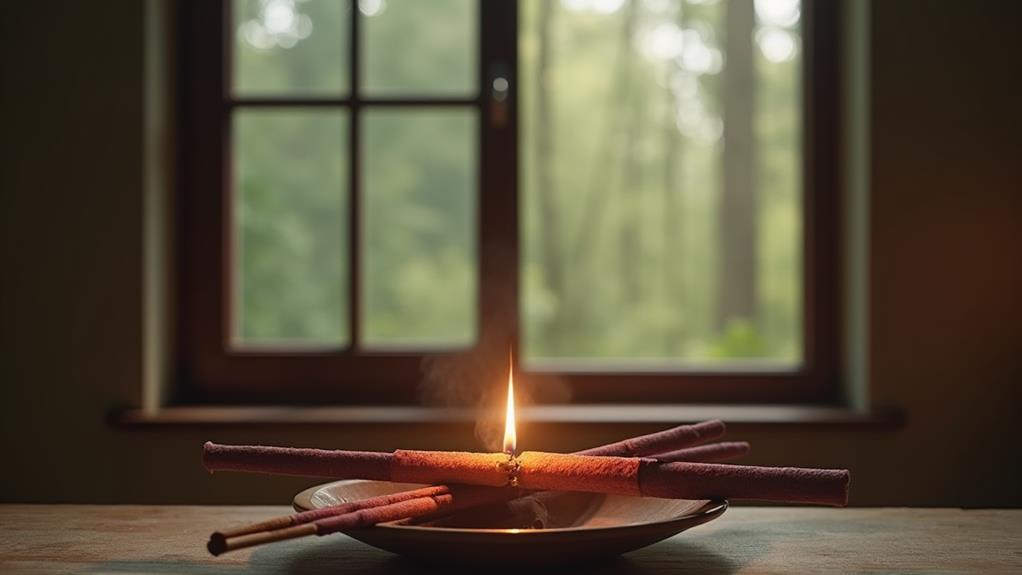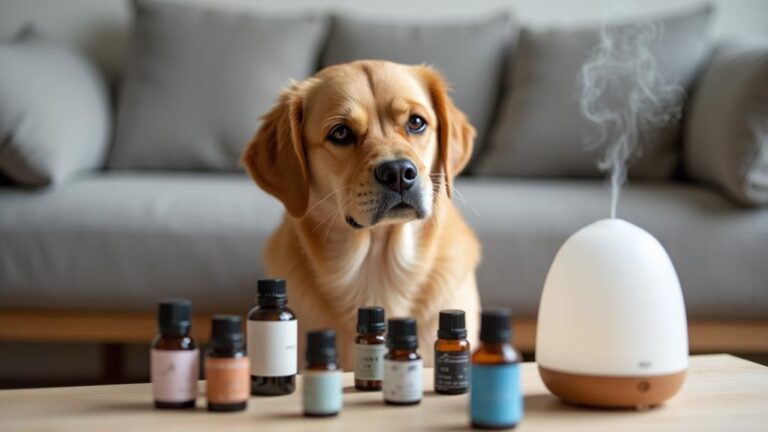When you burn essential oils, you're likely seeking their therapeutic benefits and pleasant aromas. However, some oils release toxic compounds into the air that can have serious health consequences. If you're not careful, you could be exposing yourself and your loved ones to hazardous fumes. Certain essential oils contain toxic compounds that can cause liver damage, skin irritation, and even cancer when inhaled. So, which oils should you avoid at all costs, and what safer alternatives can you turn to? Understanding the risks and benefits of essential oil burning is vital to creating a healthier environment.
Key Takeaways
- Avoid pennyroyal, cassia, cinnamon, sassafras, and wintergreen oils due to their toxic compounds and potential health risks.
- Limit burning time to 1-2 hours and trim wicks to 1/4 inch to reduce toxin release and prevent overheating.
- Open windows and use fans to circulate air and decrease concentration of volatile compounds from essential oils.
- Choose essential oils that complement each other in terms of chemical composition and fragrance profiles for safe aromatherapy.
- Research the chemical composition of each essential oil and look for certifications from reputable organizations like NAHA or ISO.
Risks of Burning Essential Oils
When you burn essential oils, you're releasing their volatile compounds into the air, which can be beneficial, but also pose risks.
While these oils can have therapeutic properties, they can also affect air quality and potentially harm human health. The lack of essential oil regulations and standards for air quality makes it challenging to determine the safe levels of exposure to these compounds.
The Occupational Safety and Health Administration (OSHA) and the Environmental Protection Agency (EPA) have established air quality standards for certain chemicals found in essential oils, such as particulate matter, volatile organic compounds (VOCs), and other pollutants.
However, these standards don't specifically address essential oils, leaving a gap in regulations. As a result, it's up to you to be aware of the potential risks and take steps to minimize exposure.
Understanding the composition of essential oils and their potential impact on air quality is vital in mitigating these risks. By being informed, you can make better decisions about using essential oils in your home or workspace.
Safe Burning Practices
To minimize the risks associated with burning essential oils, vital to adopt safe practices that reduce exposure to their volatile compounds. When burning essential oils, you should prioritize candle care and take steps to maintain a safe and pleasant room ambiance.
To guarantee safe burning practices, consider the following guidelines:
| Practice | Description | Benefits |
|---|---|---|
| Candle maintenance | Regularly trim wicks to 1/4 inch and remove debris | Reduces soot and toxin release |
| Ventilation | Open windows and use fans to circulate air | Decreases concentration of volatile compounds |
| Burning duration | Limit burning time to 1-2 hours | Prevents overheating and reduces toxin release |
Oils to Avoid Burning
When using essential oils for burning, you'll want to be cautious with certain oils that can release harmful compounds into the air.
Some essential oils, such as pennyroyal and wintergreen, contain toxic compounds that can be released during the burning process, posing health risks to you and those around you.
To guarantee safe use of aromatherapy in your home, verify and abstain from burning these oils to safeguard against harm.
Harmful Essential Oils
Frequently, essential oils are perceived as harmless due to their natural origins. However, this notion can be misleading, leading to essential myths and oil misconceptions.
You should be aware that some essential oils can be hazardous to your health, especially when burned.
Cassia oil, for instance, contains cinnamaldehyde, which can cause skin irritation and allergic reactions when inhaled.
You should also exercise caution with cinnamon oil, as its high levels of cinnamaldehyde can lead to respiratory problems when burned in large quantities.
Another oil to be wary of is pennyroyal oil, which contains pulegone – a compound that can cause liver damage and other adverse health effects when inhaled.
Additionally, you should use sassafras oil with caution, as its main component, safrole, is a known carcinogen.
Crucial to note is that even if an oil is natural, it can still pose health risks, so you should research each oil's properties and potential hazards before using it.
By being informed, you can avoid the risks associated with burning essential oils and enjoy their benefits safely.
Always consult with a healthcare professional or certified aromatherapist before using any essential oil.
Oils to Refrain From
Essential oil quality is vital when it comes to burning. Always opt for high-quality oils that are free from adulterants and contaminants.
Additionally, be mindful of oil blending mistakes, as combining certain oils can create toxic fumes. For instance, blending tea tree oil with other oils can increase its toxicity.
You should research the safe blending ratios and guidelines before creating your own oil blends for burning. By avoiding certain essential oils and being mindful of oil quality and blending, you can minimize the risks associated with burning essential oils and create a safer environment for yourself and others.
Toxic Fume Effects on Health
As you inhale toxic fumes from essential oils, the particles rapidly enter your lungs, triggering a cascade of biochemical reactions that can have devastating effects on your health.
Fume exposure can lead to lung damage, characterized by inflammation and irritation in the airways. This can cause respiratory issues such as bronchitis, asthma, and other breathing difficulties.
Prolonged exposure to toxic essential oil fumes can also lead to oxidative stress, a condition in which the body's natural antioxidant defenses are overwhelmed by free radicals.
This can result in cellular damage and potentially even DNA mutations, increasing your risk of chronic diseases like cancer and cardiovascular disease.
Furthermore, the volatile organic compounds (VOCs) present in toxic essential oil fumes can also affect your nervous system, leading to symptoms such as headaches, dizziness, and nausea.
In severe cases, VOC exposure can even lead to neurological damage and cognitive impairment.
It's vital to be aware of the potential health risks associated with toxic essential oil fumes and take steps to minimize your exposure.
Burning Oils Around Pets
When burning essential oils around pets, you must consider their safety, as pets are more sensitive to toxic fumes than humans.
Certain oils can be hazardous to your pets' health, even in small amounts, so it's vital to know which oils to avoid and how to use them safely.
Pet Safety Precautions
Burning oils around pets can pose significant risks to their health and well-being.
As a pet owner, vital precautions must be taken to safeguard your furry friends' safety when using essential oils in your home.
When burning essential oils around pets, paramount importance should be given to their unique physiology and sensitivity.
Pets, especially dogs and cats, have a more sensitive sense of smell and a faster metabolism than humans, making them more susceptible to the effects of essential oils.
Pet safety precautions to keep in mind:
- Keep essential oils out of reach: Store essential oils in a secure location where pets can't access them.
- Use a diffuser with a timer: This allows you to regulate the amount of oil released into the air and avoid overwhelming your pet.
- Monitor your pet's behavior: Watch for signs of distress, such as panting, pacing, or lethargy, and adjust the oil usage accordingly.
Toxic Oils to Avoid
Some essential oils can be particularly hazardous to your pets if inhaled through burning. When burning essential oils around pets, it's vital to know which oils to avoid.
Certain oils, such as pennyroyal, blue cypress, and hyssop, contain toxic compounds that can cause seizures, tremors, and even coma in pets. These oils can also exacerbate respiratory issues, such as asthma, in pets.
Due to the lack of essential oil regulation, it's up to you to research and confirm the oils you use are safe for your pets.
Look for oils that adhere to strict sourcing standards, such as GC/MS testing and third-party certification. This will help you identify oils that contain toxic compounds and avoid them.
Additionally, always read the label and look for warnings about pet safety. If you're unsure about the safety of an oil, it's best to err on the side of caution and avoid using it around your pets.
Remember, your pet's safety is your responsibility, and taking the time to research and choose safe oils can help prevent harm.
Safe Burning Alternatives
Pet-friendly essential oil use often involves substituting hazardous oils with safer alternatives.
When burning oils around pets, it's vital to choose options that won't harm them.
Consider the following safe alternatives:
1. Essential blends: Look for pre-mixed blends that are specifically labeled as pet-friendly. These blends are often designed to be gentle and non-toxic, making them a great option for homes with pets.
2. Aromatic potpourri: Instead of burning essential oils, try using aromatic potpourri made from dried flowers, herbs, and spices.
This can create a pleasant atmosphere without the risks associated with essential oils.
3. Diffuser-free alternatives: If you still want to enjoy essential oils, consider using diffuser-free alternatives like scented candles or room sprays.
These options can provide a similar ambiance without the risks of burning oils around pets.
When choosing safe alternatives, always read labels carefully and look for certifications from reputable organizations.
Choosing Safe Essential Oils
Most essential oils can be safely used when you follow proper guidelines and choose high-quality products.
When selecting essential oils for burning, consider the potential risks associated with certain oils. Opt for single oils or essential oil blends that are known to be safe for aromatherapy.
When creating scented recipes, choose essential oils that complement each other in regard to their chemical composition and fragrance profiles.
For example, combining lavender and chamomile can create a calming and soothing atmosphere. However, avoid mixing oils that can react with each other or release toxic compounds when heated.
Research the chemical composition of each essential oil and look for certifications from reputable organizations, such as the National Association for Holistic Aromatherapy (NAHA) or the International Organization for Standardization (ISO).
This guarantees that the oils meet certain standards for quality and safety. Always read the label carefully and follow the recommended usage guidelines to minimize the risk of adverse effects.
Frequently Asked Questions
Can I Burn Essential Oils Around My Fish Tank?
When burning essential oils around your fish tank, you'll want to choose fish-friendly options to maintain aquatic safety. Opt for calming oils like lavender or chamomile, but always research their safety and use them in moderation.
How Long Does It Take for Fumes to Dissipate?
You might assume fumes dissipate instantly, but actually, it takes around 30 minutes to several hours for them to clear, depending on air circulation, temperature, and fume duration in your space.
Can I Mix Toxic Oils With Safe Ones for Burning?
When blending essential oils, you're creating a new risk profile. Blended risks are hard to predict, so it's best not to mix toxic oils with safe ones, as oil ratios can be difficult to control.
Are Scented Candles Safer Than Essential Oil Burners?
"Comparing apples to oranges," you're weighing scented candles against essential oil burners. Scented candles pose risks like soot release, while their oil alternatives can be just as hazardous, offering no clear safety advantage.
Can I Burn Essential Oils in Small, Enclosed Spaces?
When burning essential oils in small, enclosed spaces, you must consider space constraints and ventilation importance. Inadequate airflow can lead to concentrated oil particles and reduced oxygen levels, potentially causing health issues and discomfort to you.
Conclusion
As you navigate the world of essential oils, remember that the air you breathe is a canvas – every substance you burn leaves a lasting brushstroke. To guarantee a masterpiece of wellness, choose your oils wisely and avoid the toxic ones that can mar the picture. By selecting safe, high-quality oils and following proper guidelines, you'll create a haven of serenity and health that benefits both you and those around you.














